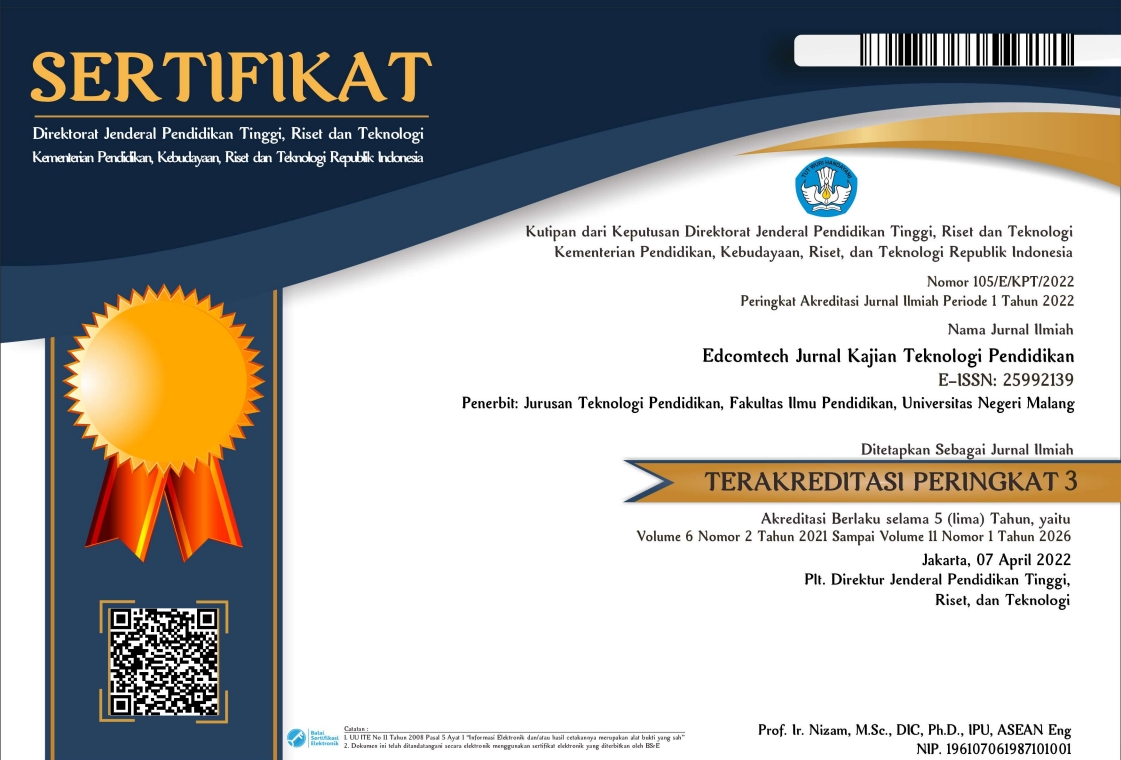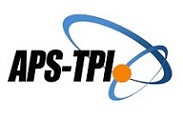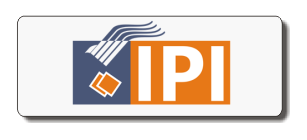Pengembangan E-Modul Pembelajaran Agama Kristen Menggunakan Scaffolding untuk Meningkatkan Kemampuan Metakognitif Komunitas Remaja Kristen Sumba
Abstract
Abstrak: Tujuan dari penelitian ini adalah untuk menghasilkan modul elektronik menggunakan scaffolding dalam pembelajaran agama Kristen bagi komunitas remaja Kristen Sumba, serta menguji kelayakannya. Model pengembangan yang digunakan adalah model ADDIE yang mencakup langkah Analyze, Design, Development, Implementation dan Evaluation. Produk E-modul menggunakan scaffolding ini memiliki tingkat kelayakan materi 97,5%, kelayakan desain pembelajaran 96,25%, dan kelayakan media pembelajaran 95%. Sedangkan tingkat kelayakannya berdasarkan uji coba perorangan adalah 99,16 %, berdasarkan uji coba kelompok kecil adalah 96,67% dan berdasarkan uji coba lapangan 94,71% dengan kualifikasi sangat layak dan tidak perlu direvisi. Selain itu, hasil uji efektivitas penggunaan e-modul masuk kualifikasi efektif berdasarkan pre test dan post test.
Abstract: The aim of this research is to produce an electronic module that uses scaffolding in Christian Instructional for Sumba Christian Adolescence Community, as well as examining the feasibility. The Development Model used is the ADDIE model which completes the steps of Analysis, Design, Development, Implementation, and Evaluation. This product has a material level of 97,5%, the feasibility of instructional design 96,25%, and feasibility of instructional media expert 95%. Additionally, the trial rate based on individual trials is 99,16%, based on small group trials is 96,67%, and based on field trials 94,71% with very decent qualifications and do not need to be revised. In addition, the result of the effectiveness of the use of e-modules into effective qualifications based on pre-test and post-test.
Keywords
Full Text:
PDFReferences
Ali, A. Z. M., Wahid, R., Samsudin, K., & Idris, M. Z. (2013). Reading on the Computer Screen: Does Font Type has Effects on Web Text Readability? International Education Studies, 6(3), p26. https://doi.org/10.5539/ies.v6n3p26
Aloumi, A. E. (2013). E E ect of Colour Contrast Combinations on the Simplicity and Complexity of Design. Bournemouth University, School of Design, Engineering and Computing.
An, Y.-J., & Cao, L. (2014). Examining the effects of metacognitive scaffolding on students’ design problem solving and metacognitive skills in an online environment. Journal of Online Learning and Teaching, 10(4), 552.
Arikunto, S. (2010). Penelitian tindakan. Yogyakarta: Aditya Media.
Bakker, A., Smit, J., & Wegerif, R. (2015). Scaffolding and dialogic teaching in mathematics education: Introduction and review. ZDM, 47(7), 1047–1065.
Belland, B. R. (2017). Instructional Scaffolding in STEM Education. Springer International Publishing. https://doi.org/10.1007/978-3-319-02565-0
Bramer, P. (2010). Introduction to the special focus: Spiritual formation and Christian education. SAGE Publications Sage UK: London, England.
Camnalbur, M., & Mutlu, D. (2011). Review About Font Typography On Instructional Design. Review About Font Typhography On Instructional Design, 5, 5.
Cobern, W. W. (2012). Contextual constructivism: The impact of culture on the learning and teaching of science. In The practice of constructivism in science education (pp. 67–86). Routledge.
Fadli, F. (2019). Penerapan Metode Inkuiri dalam Meningkatkan Keterampilan Berpikir Kritis dan Keaktifan Belajar Siswa Pada Mata Pelajaran PAI di MTs Al-Amin Pekalongan. Edcomtech Jurnal Kajian Teknologi Pendidikan, 4, 19–26.
Galotti, K. M. (2015). Cognitive development: Infancy through adolescence. Sage Publications.
Hamidi, E., & Bagherzadeh, R. (2018). The logical problem of scaffolding in second language acquisition. Asian-Pacific Journal of Second and Foreign Language Education, 3(1), 19.
Hapsari, N. D., Toenlioe, A. J. E., & Soepriyanto, Y. (2018). Pengembangan Augmented Reality Video Sebagai Suplemen Pada Modul Bahasa Isyarat. JKTP. Jurnal Kajian Teknologi Pembelajaran, 1, 185–193.
Levin, P. (2015). Ego states and emotional development in adolescence. Transactional Analysis Journal, 45(3), 228–237.
Majidi, N., & Aydinlu, N. A. (2016). The Effect of Contextual Visual Aids on High School Students’ Reading Comprehension. Theory and Practice in Language Studies, 6(9), 1827. https://doi.org/10.17507/tpls.0609.15
Meltzer, D. E. (2002). The relationship between mathematics preparation and conceptual learning gains in physics: A possible “hidden variable” in diagnostic pretest scores. American Journal of Physics, 70(12), 1259–1268.
Mohtadi, M. T., Hajami, A., & Allali, H. (2014). Pedagogical agent for metacognitive scaffolding in interactive learning environments. 2014 International Conference on Multimedia Computing and Systems (ICMCS), 652–656.
Molenda, M. (2003). In search of the elusive ADDIE model. Performance Improvement, 42(5), 34–36. https://doi.org/10.1002/pfi.4930420508
Prastowo, A. (2015). Panduan Kreatif membuat Bahan Ajar Inovatif Cet VIII. Jogjakarta: Diva Press.
Raes, A., Schellens, T., De Wever, B., & Vanderhoven, E. (2012). Scaffolding information problem solving in web-based collaborative inquiry learning. Computers & Education, 59(1), 82–94.
Reynolds, D., & Goodwin, A. (2016). Supporting students reading complex texts: Evidence for motivational scaffolding. AERA Open, 2(4), 2332858416680353.
Sawyer, S. M., Azzopardi, P. S., Wickremarathne, D., & Patton, G. C. (2018). The age of adolescence. The Lancet Child & Adolescent Health, 2(3), 223–228.
Shobirin, M. (2020). Pengembangan Modul IPA Kelas VI dengan Model Cooperative Learning. Edcomtech Jurnal Kajian Teknologi Pendidikan, 5(1), 24–37. https://doi.org/10.17977/um039v5i12020p024
Sholihah, M., Zubaidah, S., & Mahanal, S. (2016). Memberdayakan Keterampilan Metakognitif dan Hasil Belajar Kognitif Siswa Dengan Model Pembelajaran Reading Concept Map-Reciprocal Teaching (REMAP RT). Jurnal Pendidikan: Teori, Penelitian dan Pengembangan, 1, 628–633.
Simanjuntak, J. M. (2014). Implikasi Konsep Dan Desain Kurikulum Dalam Tugas Pembinaan Warga Jemaat. Jurnal Jaffray, 12(2), 251–272.
Surahman, E., Sulthoni, S., Ulfa, S., Husna, A., Ramdiana, H., Thaariq, Z. Z. A., Setiawan, A. B., & Qolbi, M. S. (2020). Pelatihan Micro Learning Object Berbasis TPACK bagi Guru-Guru SMA di Garut. Abdimas Pedagogi: Jurnal Ilmiah Pengabdian Kepada Masyarakat, 3(1), 1–14.
Thaariq, Z. Z. A. (2020). The Use of Social Media as Learning Resources to Support the New Normal. Teknodika, 18(2), 80–93.
Udayana, N. N. A., Wirawan, I. M. A., & Divayana, D. G. H. (2017). Pengembangan E-Modul Pada Mata Pelajaran Pemrograman Berorientasi Objek Dengan Model Pembelajaran Project Based Learning Kelas XII Rekayasa Perangkat Lunak Di SMK Negeri 2 Tabanan. Jurnal Nasional Pendidikan Teknik Informatika (JANAPATI), 6(2), 128–139.
van de Pol, J. E. (2012). Scaffolding in Teacher-student Interaction: Exploring, Measuring, Promoting and Evaluting Scaffolding.
DOI: http://dx.doi.org/10.17977/um039v6i12021p069
Refbacks
- There are currently no refbacks.
Copyright (c) 2021 Nova Nova, I Nyoman Sudana Degeng, Sulton Sulton

This work is licensed under a Creative Commons Attribution-ShareAlike 4.0 International License.
Edcomtech: Jurnal Kajian Teknologi Pendidikan published by Department of Educational Technology, Faculty of Education, State University of Malang in Collaboration with Asosiasi Program Studi Teknologi Pendidikan Indonesia (APS TPI) and Ikatan Profesi Teknologi Pendidikan Indonesia (IPTPI) with MoU.
Publisher Address:
Lab. Teknologi Pendidikan, Gd.E2, Lt.1
Fakultas Ilmu Pendidikan Universitas Negeri Malang
Jalan Semarang No 5, Kota Malang Kode Pos 65145
Email: edcomtech.fip@um.ac.id
========================================================================================================
| INDEXED BY | TOOLS | PLAGIARISM CHECK | ARTICLE TEMPLATE |
|

Edcomtech is licensed under a Creative Commons Attribution-ShareAlike 4.0 International License.
Edcomtech Statistics (Since July 13th, 2020)












1.png)








